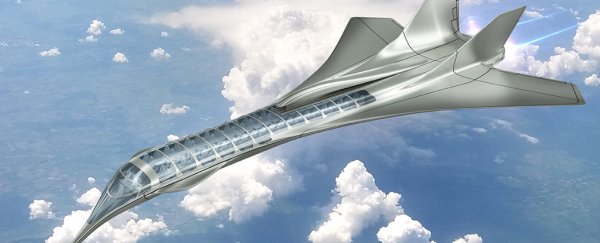The development of a new kind of ceramic capable of resisting insanely high temperatures would eliminate a major obstacle blocking the path to hypersonic air travel.
There are plenty of potential uses for a material that can deal with temperatures of 3,000° Celsius (about 5,400° Fahrenheit), especially on military and space technology, but anything that will get us across the globe in the time it takes to watch three Game of Thrones episodes has our attention.
Researchers from the University of Manchester and Central South University (CSU) in China have designed a ceramic coating that resists two of the biggest problems caused by exposure to high temperatures – ablation and oxidation.
Expose any material to a high enough temperature and its molecules will jiggle loose and fall off, especially if they're being scoured by high speed particles speeding by. That's ablation.
The second is the souped up reaction with oxygen changing the molecular structure, called oxidation.
For an aircraft to move at hypersonic speeds and not arrive toasted, you'll want to protect its components against the high temperatures caused by air compressing and rubbing against parts of its structure, especially its leading edges.
Those temperatures could potentially reach 3,000°C (5,400° Fahrenheit) at speeds considered hypersonic, between 6,174 and 12,348 kilometres per hour (3,836 to 7,673 miles per hour).
Getting passengers from London to New York in about 2 hours would revolutionise travel, and is a dream that some say could be achievable in the next decade.
Putting aside arguments on whether it would be commercially viable, especially with memories of the Concorde still fresh in our minds, that pesky temperature problem would be just one of the many technological issues in need of a solution.
The current answer would be to cover them with ultra-high temperature ceramics (UHTCs); solid non-metals that stay stable at temperatures over 2,000° Celsius (about 3,600° Fahrenheit).
One UHTC commonly used to coat drill bits, engine parts, and sections of supersonic vehicles is zirconium carbide (ZrC).
Another promising candidate for high temperature coatings on aircraft would be its cousin zirconium diboride (ZrB2), which not only resists oxidation at temperatures up to 1,500° Celsius (2,700° Fahrenheit), but has low density and is relatively low cost.
Unfortunately, the boron in ZrB2 makes it susceptible to ablation when the boron atoms do oxidise, and if a single section of the material happens to fail, it does so catastrophically.
Not exactly what you want zooming through the air at Mach 5.
This new research has found an even more promising material in a new form of carbide ceramic that could resist the super high temperatures of hypersonic travel.
"Current candidate UHTCs for use in extreme environments are limited and it is worthwhile exploring the potential of new single-phase ceramics in terms of reduced evaporation and better oxidation resistance," says lead researcher Ping Xiao from the University of Manchester.
"In addition, it has been shown that introducing such ceramics into carbon fibre- reinforced carbon matrix composites may be an effective way of improving thermal-shock resistance."
The coating is a quaternary carbide mix made of zircon, titanium, carbon, and boron that is deposited into a carbon composite by a process called reactive melt infiltration.
While it has similar properties to other UHTCs, the relatively low concentration of boron makes it less likely to ablate, while the carbon structure helps prevent the thermal shock that tears apart materials like ZrB2.
"The experimental results presented here suggest the carbide coating displays better ablation resistance at 2,000-3,000°C than existing candidate UHTCs such as Zr-based carbide and diborides and other high temperature composites," the researchers write in their report.
In fact, the new material is 12 times better than ZrB2 at resisting ablation.
Sadly none of this means we'll be doing afternoon shopping in the other hemisphere any time soon. It's far more likely this kind of technology will see use in military or space applications before we're riding hypersonic planes.
Still, it's one tiny step closer.
This research was published in Nature Communications.
